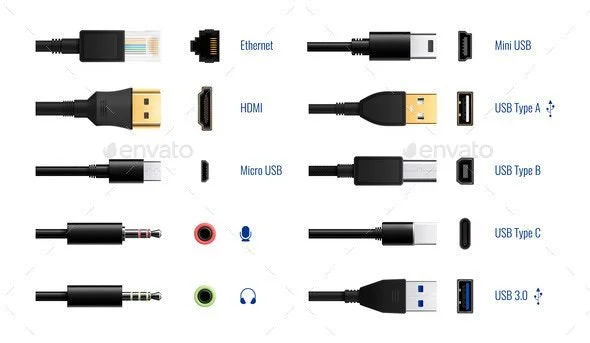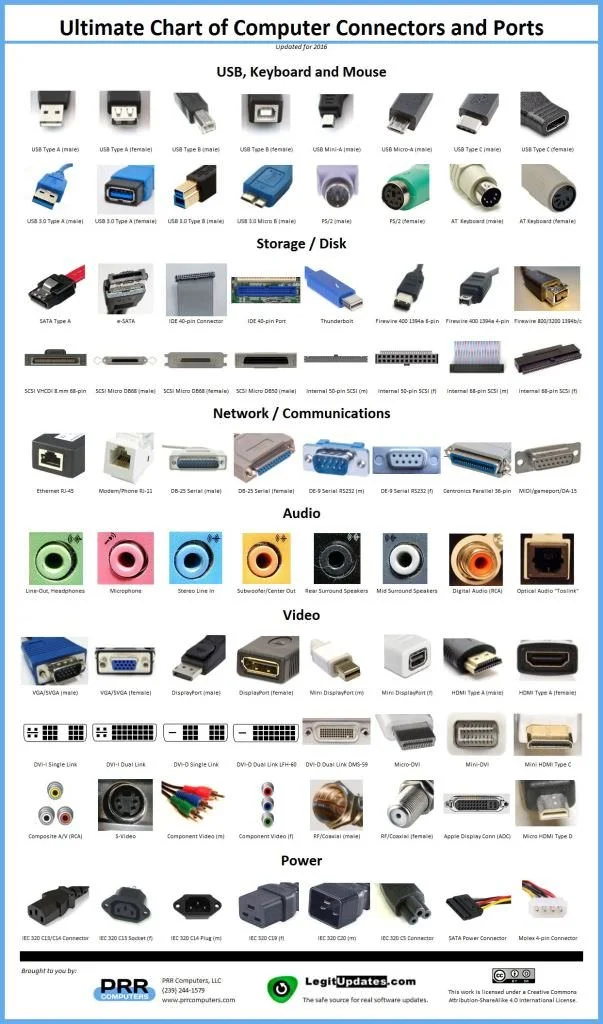USB Type A
USB Type-A port is a 4 pin connector. There are different versions of Type – A USB ports: USB 1.1, USB 2.0 and USB 3.0. USB 3.0 is the common standard and supports a data rate of 400MBps. USB 3.1 is also released and supports a data rate up to 10Gbps. Usually, but not all the times, the USB 2.0 is Black color coded and USB 3.0 is Blue.
USB Type C
USB Type – C is the latest specification of the USB and is a reversible connector. USB Type – C is supposed to replace Types A and B and is considered future proof. The port of USB Type – C consists of 24 pins. The pinout diagram of USB Type – C is shown below. The latest USB Specifications (USB4) is an USB-C only specification i.e., only USB type C devices can be used with USB4 specifications. In the latest USB4 specification, USB Type C Devices can support speeds up to 40 Gbps. USB Power Delivery specifications allow USB devices to supply power to devices connected to the USB Port. USB Type – C can handle a current of 5A at 20V (only Power Delivery certified USB Type-C Ports). This feature of handling high current is used in the latest Fast Charging Technology where a Smart Phone’s battery will reach its full charge is very less time. So, USB Type C Ports can provide up to 100W of power (which can be used for charging mobile phones and laptops). In fact, the latest Apple M1 Mac Books use 61W USB C Power Adapter.
RJ-45
Ethernet is a networking technology that is used to connect your computer to Internet and communicate with other computers or networking devices. The interface that is used for computer networking and telecommunications is known as Registered Jack (RJ) and RJ – 45 port in particular is used for Ethernet over cable. RJ-45 connector is an 8 pin – 8 contact (8P – 8C) type modular connector. The latest Ethernet technology is called Gigabit Ethernet and supports a data transfer rate of over 10Gigabits per second. The Ethernet or a LAN port with 8P – 8C type connector along with the male RJ-45 cable is shown below. The un-keyed 8P – 8C modular connector is generally referred to the Ethernet RJ-45. Often, RJ-45 ports are equipped with two LEDs for indicating transmission and packet detection.
S/PDIF / TOSLINK
The Sony/Phillips Digital Interface Format (S/PDIF) is an audio interconnect used in home media. It supports digital audio and can be transmitted using a coaxial RCA Audio cable or an optical fiber TOSLINK connector. Most computers home entertainment systems are equipped with S/PDIF over TOSLINK. TOSLINK (Toshiba Link) is most frequently used digital audio port that can support 7.1 channel surround sound with just one cable. In the following image, the port on the right is an S/PDIF port.
HDMI
HDMI is an abbreviation of High Definition Media Interface. HDMI is a digital interface to connect High Definition and Ultra High Definition devices like Computer monitors, HDTVs, Blu-Ray players, gaming consoles, High Definition Cameras etc. HDMI can be used to carry uncompressed video and compressed or uncompressed audio signals. The HDMI port of type A is shown below. The HDMI connector consists of 19 pins and the latest version of HDMI i.e. HDMI 2.0 can carry digital video signal up to a resolution of 4096×2160 and 32 audio channels.
Mini HDMI
With HDMI 1.3 Version, a new HDMI Port and Connector combination is released called the Mini HDMI. Physically, it is smaller than a regular HDMI Port but has same 19 Pin. Intended for portable devices like laptops, cameras, camcorders, the Mini HDMI Port isn’t that popular.
Micro HDMI
HDMI developers introduced a new HDMI Connector and Port called Micro HDMI with HDMI Version 1.4. Micro HDMI also has 19 pins (just like regular HDMI and Mini HDMI) but the pinout is different. Micro HDMI is often used in cameras, single board computers (like Raspberry Pi 4), etc. where physically it is difficult to include a regular HDMI port.
VGA Port
VGA port is found in many computers, projectors, video cards and High Definition TVs. It is a D-sub connector consisting of 15 pins in 3 rows. The connector is called as DE-15. VGA port is the main interface between computers and older CRT monitors. Even the modern LCD and LED monitors support VGA ports but the picture quality is reduced. VGA carries analogue video signals up to a resolution of 648X480. With the increase in use of digital video, VGA ports are gradually being replaced by HDMI and Display Ports. Some laptops are equipped with on-board VGA ports in order to connect to external monitors or projectors.
Digital Video Interface (DVI)
DVI is a high speed digital interface between a display controller like a computer and a display device like a monitor. It was developed with an aim of transmitting lossless digital video signals and replace the analogue VGA technology. There are three types of DVI connectors based on the signals it can carry: DVI-I, DVI-D and DVI-A. DVI-I is a DVI port with integrated analogue and digital signals. DVI-D supports only digital signals and DVI-A supports only analogue signals. The digital signals can be either single link or dual link where a single link supports a digital signal up to 1920X1080 resolution and a dual link supports a digital signal up to 2560X1600 resolution. The following image compares the structures of DVI-I, DVI-D and DVI-A types along with the pinouts.
Mini-DVI
Mini-DVI port is developed by Apple as an alternative to Mini-VGA port and is physically similar to one. It is smaller than a regular DVI port. It is a 32 pin port and is capable of transmitting DVI, composite, S-Video and VGA signals with respective adapters.
Micro-DVI
Micro-DVI port, as the name suggests is physically smaller than Mini-DVI and is capable of transmitting only digital signals. This port can be connected to external devices with DVI and VGA interfaces and respective adapters are required. In the following image, a Micro-DVI port can be seen adjacent to headphone and USB ports.
Display Port
Display Port is a digital display interface with optional multiple channel audio and other forms of data. Display Port is developed with an aim of replacing VGA and DVI ports as the main interface between a computer and monitor. The latest version DisplayPort 1.3 can handle a resolution up to 7680 X 4320. The Display Port has a 20 pin connector, which is a very less number when compared to DVI port and offers better resolution.
Mini DisplayPort
Apple introduced a miniature version of DisplayPort and called it Mini DisplayPort (mDP or Mini DP). Even though Mini DisplayPort has 20 pins, the physical size of the connector is smaller than a regular DisplayPort and the pin out is also different. Most laptops provide Mini DisplayPort as an additional video out option in addition to HDMI.


